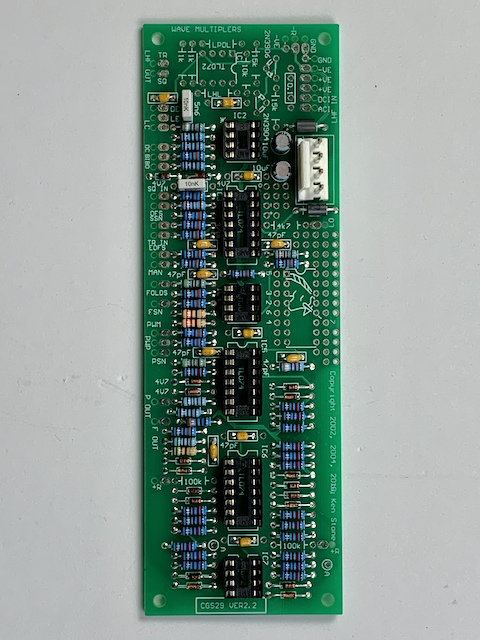I upgraded my CGS29 Wave Multiplier from board rev. 1.0 to 2.2. The v2.2 PC board is available from SynthCube.

Turned out I had all the needed parts and could swap in the ICs from the old board, plus one added TL072 op amp that adds two stages to the folder. The new board is double-sided with plated-through holes; the old one was single-sided.
Why upgrade?
I had been reviewing a lot of wave folders for Eurorack and realized that I should revisit my Wave Multiplier. It sounded great. I decided to upgrade to get some benefits of the later design:
- Two extra folding stages added to the main multiplier
- Extra power supply bypassing
- Additional capacitors to reduce parasitic oscillations
A third wave shaper was added to the board: a Lockhart frequency tripler. But since I have an original Stooge panel (designed by Larry Hendry), there is no panel space for it, so it’s omitted from the build.
Old and new schematics


Swapping the boards




Amazingly, only one wire was too short and had to be extended. The main problem/challenge was that the v1.0 board had plenty of ground lands where the black wires of the twisted pairs could be soldered. The new board had no ground lands. But fortunately v2.2 has empty holes next to each land, ostensibly for inserting the wire through from the back. I soldered all the wires into the top of the board. For the grounds, I simply added a piece of bus wire, running along the edge of the board, soldered at each end to grounds. I simply pushed the black wires through and soldered them to the bus wire.



How it sounds now
I would say that the new version sounds cleaner than the old one, maybe due to better bypassing and method of limiting the pulse and grinder outputs. It is a well-behaved wave folder, staying within the +/-5V output range, even when changing the input offset. I didn’t modify the PWM circuit to increase the range (as I did on v1.0), so it’s somewhat shallow. Larry Hendry chose to have a PWM depth pot, rather than an initial width pot. There are two PWM CV inputs, one attenuated and the other not, both at the same sensitivity.
